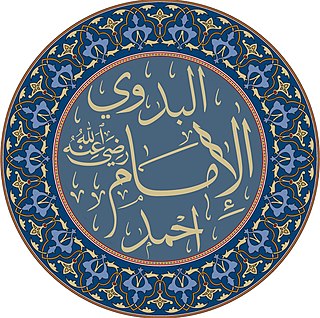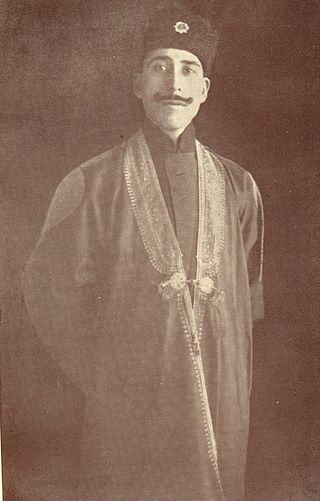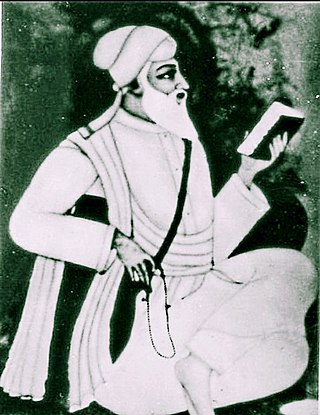
Sufism, also known as Tasawwuf, is a mystic body of religious practice emerged from the teachings of Ali recited by Hasan al-Babri, today found not only within Sunni Islam but also within Shia Islam, which is characterized by a focus on Islamic purification, spirituality, ritualism, asceticism and esotericism. It has been variously defined as "Islamic mysticism", "the mystical expression of Islamic faith", "the inward dimension of Islam", "the phenomenon of mysticism within Islam", the "main manifestation and the most important and central crystallization" of mystical practice in Islam, and "the interiorization and intensification of Islamic faith and practice".

A tariqa is a school or order of Sufism, or specifically a concept for the mystical teaching and spiritual practices of such an order with the aim of seeking haqiqa, which translates as "ultimate truth".

The Naqshbandi is a major Sunni order of Sufism. Its name is derived from Baha-ud-Din Naqshband Bukhari. Naqshbandi masters trace their lineage to the Islamic prophet Muhammad through Abu Bakr, the first Caliph of Sunni Islam and Ali, the fourth Caliph of Sunni Islam. It is because of this dual lineage through Ali and Abu Bakr through the 6th Imam Jafar al Sadiq that the order is also known as the "convergence of the two oceans" or "Sufi Order of Jafar al Sadiq".

Aḥmad al-Badawī, also known as Al-Sayyid al-Badawī, or as al-Badawī for short, or reverentially as Shaykh al-Badawī by all those Sunni Muslims who venerate saints, was a 13th-century Arab Sufi Muslim mystic who became famous as the founder of the Badawiyyah order of Sufism. Born in Fes, Morocco to a Bedouin tribe originally from the Syrian Desert, al-Badawi eventually settled for good in Tanta, Egypt in 1236, whence he developed a posthumous reputation as "One of the greatest saints in the Arab world" As al-Badawi is perhaps "the most popular of Muslim saints in Egypt", his tomb has remained a "major site of visitation" for Muslims in the region.

The Qadiriyya are members of the Sunni Qadiri tariqa. The tariqa got its name from Abdul Qadir Gilani, who was a Hanbali scholar from Gilan, Iran. The order relies strongly upon adherence to the fundamentals of Sunni Islamic law.

Sufism is the mystical branch of Islam in which Muslims seek divine love and truth through direct personal experience of God. This mystic tradition within Islam developed in several stages of growth, emerging first in the form of early asceticism, based on the teachings of Hasan al-Basri, before entering the second stage of more classical mysticism of divine love, as promoted by al-Ghazali and Attar of Nishapur, and finally emerging in the institutionalized form of today's network of fraternal Sufi orders, based on Sufis such as Rumi and Yunus Emre. At its core, however, Sufism remains an individual mystic experience, and a Sufi can be characterized as one who seeks the annihilation of the ego in God.

Sufi studies is a particular branch of comparative studies that uses the technical lexicon of the Islamic mystics, the Sufis, to exemplify the nature of its ideas; hence the frequent reference to Sufi Orders. It may be divided into two main branches, the orientalist/academic and the spiritual.

Sirdar Ikbal Ali Shah was an Indian-Afghan author and diplomat descended from the Sadaat of Paghman. Born and educated in India, he came to Britain as a young man to continue his education in Edinburgh, where he married a young Scotswoman.
Muhammad GhawthGwaliyari (1500–1562) was a 16th-century Sufi master of the Shattari order and Sufi saint, a musician, and the author of Jawahir-i Khams. The book mentioning the life and miracles of Gaus named " Heaven's witness" was written by Kugle.

Hashim peer Dastagir was an Indian Sufi saint according to the tradition of the Qadri Shattari Sufi order. His shrine is in Bijapur, Karnataka, India.

Khwaja Haji Dost Muhammad Qandhari was an Afghan Sufi master in the Naqshbandi tradition in the 19th century (1801–1868).

Lataif-e-sitta are special organs of perception in Sufi spiritual psychology, subtle human capacities for experience and action. Depending on context, the lataif are also understood to be the corresponding qualities of that experience or action.

Sayyid ul Sadaat Sayyid Mir Jan also known as Hazrat Shah Saheb is a Qutb from Kabul.

Sayyid ul Sadaat Khwaja Sayyid Mir Khawand Mahmud ibn Sharifuddin -Naqshbandi Al-Hasani wal Husseini, known as Hazrat Ishaan Shah Saheb was a Qutb from Bukhara, Uzbekistan.

Abd al-Rauf ibn Ali al-Fansuri al-Sinkili was a well-known Islamic scholar, spiritual leader of the Shattariyya tariqa and the mufti of Aceh Sultanate. He was the confidant of Sultana Safiyat al-Din. He was considered the first person to spread the Shattari Sufi order in Indonesia and Southeast Asia. Many of his students also became disseminators of Islam. He is commonly known as Shaikh Abd al-Rauf al-Sinkili, and also known posthumously in Aceh as Teungku Syiah Kuala, which translates to "Sheikh in the Estuary".
Siraj al-Din Abdullah Shattar was a prominent 15th-century Sufi master, considered to be the eponymous founder of the Shattariyya order. He brought his sufism order from Transoxiana to South Asian subcontinent, where his successors developed it further. In the late 16th-century, the order was introduced to the Haramain, and through them to Southeast Asia.
Burhan al-Din Ibrahim ibn Hassan ibn Shihab al-Din al-Kurani al-Madani, was a Gorani Kurdish Sufi master (murshid) and Athari theologian who was born in the village of Shahrani in Shahrizor plain. He was also attributed with al-Kurdi, al-Shahrazuri, and al-Shahrani. He studied and was a member of several Sufi orders (tariqa), especially the Naqshbandi, the Qadiri, and the Shattari. In Medina, he became Ahmad al-Qushashi's prominent and influential student, and succeeded Al-Qushashi as the leader of his order. His writings cover various Islamic subjects, including jurisprudence (fiqh), theology (tawhid), and Sufism.
ʿAli Shīr al-Ḥanafī al-Bangālī, or simply Ali Sher Bengali, was a 16th-century Bengali author, teacher and Sufi pir of the Shattari order. He was one of the three khalifahs (successors) of Muhammad Ghawth Shattari.
Al-Ghazzi is a prominent family based in Damascus. It was best known for producing noted ulema and other scholars and the leadership of the Shafi'i madhhab in Damascus during late Mamluk (1260–1517) and Ottoman rule (1517–1918). Toward the end of Ottoman rule, throughout French rule (1920–1946) and following Syria's independence in 1946 several members of the family held political office, including at the national level, and as prominent professionals and journalists.









